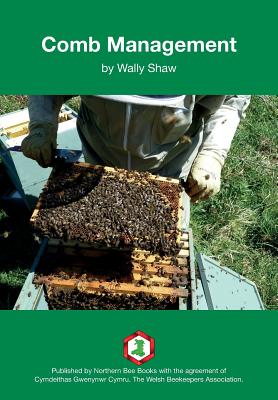Comb Management

Comb Management
Honey bees can successfully live in all sorts of different nest sites - a hole
in a tree, a chimney pot or a bee-hive - but in all cases this is just a cavity in
which to make a set of combs. It is in and on these combs that all the within
the colony functions occur. Because it is dark in the hive, communication is
through pheromones or vibration and combs provide the ideal carrier for this
information. For example, bees can always locate the queen by following
the trail of her footprint pheromone on the combs. The main outside the
hive activities are foraging, swarming and queen mating. As beekeepers,
interested in the production of honey, we tend to concentrate on the foraging
activities of our bees and it is easy to overlook the fact that over 95% of a
typical worker bee's life is spent within the confines of the colony engaged in
some activity in or on the combs. In a sense, the combs are an extension of
the bees that made them and it is bees and combs together that constitute
the colony.
Up until about 1850, bee colonies, whether wild of under human stewardship
(it hardly qualified as management), built themselves a set of combs entirely
according to their own design in whatever cavity they could find or was
provided by the beekeeper. No restriction was placed on the way the colony
used these combs to engage in their main activities of brood rearing and food
storage. With the introduction of the moveable frame hive, followed quickly by
the invention of wax foundation and the queen excluder, everything changed.
Beekeepers were now able to induce the bees to make their combs where
they (the beekeepers) wanted them, ie in wooden frames. The beekeeper
could now even influence the size of cells they built by the dimensions of the
hexagon embossed on the sheet of wax. It also became possible to separate
the use of combs for brood rearing and honey storage using a queen excluder.
Some of the changes that modern beekeeping has imposed on colonies have
potential effects on the health and welfare of the bees and others do not.
PRP: 90.93 Lei
Acesta este Prețul Recomandat de Producător. Prețul de vânzare al produsului este afișat mai jos.
81.84Lei
81.84Lei
90.93 LeiLivrare in 2-4 saptamani
Descrierea produsului
Honey bees can successfully live in all sorts of different nest sites - a hole
in a tree, a chimney pot or a bee-hive - but in all cases this is just a cavity in
which to make a set of combs. It is in and on these combs that all the within
the colony functions occur. Because it is dark in the hive, communication is
through pheromones or vibration and combs provide the ideal carrier for this
information. For example, bees can always locate the queen by following
the trail of her footprint pheromone on the combs. The main outside the
hive activities are foraging, swarming and queen mating. As beekeepers,
interested in the production of honey, we tend to concentrate on the foraging
activities of our bees and it is easy to overlook the fact that over 95% of a
typical worker bee's life is spent within the confines of the colony engaged in
some activity in or on the combs. In a sense, the combs are an extension of
the bees that made them and it is bees and combs together that constitute
the colony.
Up until about 1850, bee colonies, whether wild of under human stewardship
(it hardly qualified as management), built themselves a set of combs entirely
according to their own design in whatever cavity they could find or was
provided by the beekeeper. No restriction was placed on the way the colony
used these combs to engage in their main activities of brood rearing and food
storage. With the introduction of the moveable frame hive, followed quickly by
the invention of wax foundation and the queen excluder, everything changed.
Beekeepers were now able to induce the bees to make their combs where
they (the beekeepers) wanted them, ie in wooden frames. The beekeeper
could now even influence the size of cells they built by the dimensions of the
hexagon embossed on the sheet of wax. It also became possible to separate
the use of combs for brood rearing and honey storage using a queen excluder.
Some of the changes that modern beekeeping has imposed on colonies have
potential effects on the health and welfare of the bees and others do not.
Detaliile produsului










